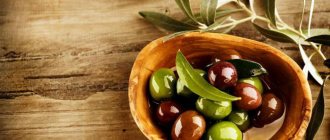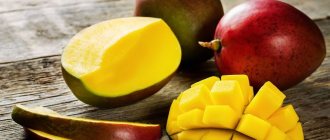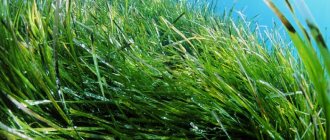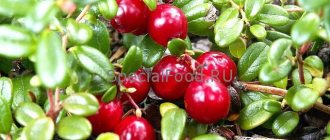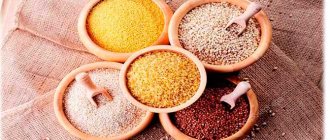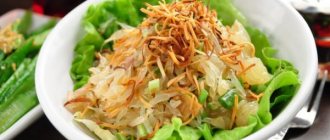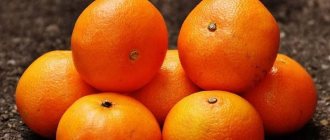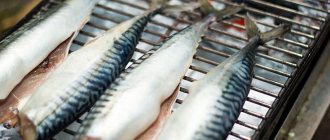Squid is a very tasty product that is attractive for cooking and eating.
But those who watch their figure and are interested in proper nutrition should know the calorie content of this product and the balance of proteins, fats and carbohydrates per 100 grams.
Like any food, squid varies in the type of preparation. The processing method determines the calorie content. Shellfish can most often be found fresh or raw, boiled, dried, dried, salted and fried.
Boiled
When cooking, the balance indicators of BJU become 21.2 g, 2.8 g, 2 g. Boiled squid has very high nutritional value. This product replenishes protein supply by 26% of the daily requirement. The amino acid composition of this protein is richer due to its natural origin. Boiled squid is suitable even for those who are trying to lose weight, as they are still low in calories and give you a feeling of fullness for a long time. Stewed clams are also beneficial.
How much protein is in squid?
A real treasure trove of protein is the squid carcass. The BJU of this product leans strongly towards the first element of the group, so the nutritional content of the shellfish is very high. The composition of raw squid (proteins, fats, carbohydrates) per 100 grams is as follows:
- carbohydrates – 0.14 g;
- proteins – 17.88 g;
- fat – 2.3 g.
Squid as a source of protein replenishes 26% of the daily requirement for this element (2000 kcal diet per day), which is a fairly high figure. The protein content in squid that has not been subjected to heat treatment reaches 72% (fat - 20%, carbohydrates - 8%).
Let's compare how much protein is in boiled squid, because with the numerous nutritional properties of the product, few would agree to consume the shellfish raw. Characterizing boiled squid, BZHU (per 100 grams) can be represented as follows:
- carbohydrates – 2 g;
- proteins – 21.2 g;
- fat – 2.8 g.
The original composition of squid after heat treatment is almost completely preserved, unlike frying (proteins are lost, fats and carbohydrates increase) or smoking (proteins increase along with calorie content).
Is squid a protein or a carbohydrate? When prepared correctly, the first without the second. Boiled squid is a recipe for the purest, easily digestible, low-calorie protein booster.
Dried
The further you go, the more calories you get. It is not without reason that those who carefully monitor their diet eat mostly boiled food. Jerky, dried or salted foods have too many calories. Dried squid contains as much as 237 kcal in 100 grams, and the BJU is 62g/2g/5g. And the seasonings used reduce their benefits. Salt causes water retention, which leads to swelling. The body is not washed away from toxins and accumulates toxins.
Calorie content
Everyone knows about the low energy value of this seafood. In its raw form, it is indeed low in calories, but the final value depends on how you cook it. So, here are the most common options for serving shellfish and its nutritional value per 100 grams:
- Raw – 92 kcal.
- Canned – 95 kcal.
- Stewed – 97.6 kcal.
- Boiled – 122 kcal.
- Fried – 174.6 kcal.
- Torn – 181 kcal.
- In batter – 188.8 kcal.
- Dried – 237 kcal.
- Smoked – 242 kcal.
- Dried - 248.6 kcal.
As you can see, the figures vary greatly. They should be taken into account by those losing weight. If you want to lose weight, then it is advisable to boil or stew shellfish, or at least fry them.
Fried
No matter how delicious fried food is, it is considered the most harmful. Even if these shellfish, when prepared in this way, have 176 kcal, which is less than dried ones, it is still a non-dietary food. In this cooking option, there is an imbalance of BZHU: 9.9 g./14.4 g./1.4 g. The proteins we need decrease in quantity, and the fats, which are required in smaller volumes, only increase.
Chemical composition
Squid contains a whole list of amino acids that participate in metabolism as enzymes and can be the building material of muscles and cells.
The amino acids in squid, their percentage and brief beneficial properties are as follows:
- Tryptophan - 25.3%: formation of serotonin and melatonin;
- Threonine - 31.3%: promotes normal growth;
- Isoleucine - 39%: treatment of muscular dystrophy;
- Leucine - 27.5%: increases immunity;
- Lysine - 32%: helps in the absorption of iron and zinc;
- Methionine - 22.4%: cleansing of toxins;
- Cystine - 13.4%: reduces the harmful effects of alcohol and nicotine;
- Phenylalanine - 14.9%: improves working memory;
- Tyrosine - 13.1%: improvement of conscious functions during periods of stress;
- Valine - 31.4%: regulates nitrogen concentration;
- Arginine - 21.1%: regulates blood pressure;
- Histidine - 16.6%: regulates blood acidity;
- Alanine - 16.2%: improves the health of hair, nails and skin;
- Aspartic amino acid – 13.9%: relieves chronic fatigue;
- Glutamic acid - 19%: improves concentration and memory;
- Glycine - 31.7%: breaks down fatty acids;
- Proline - 17.4%: improves skin structure;
- Serine - 9.8%: significant for muscle growth.
And the taurine contained later helps reduce cholesterol. B vitamins (B1, B2, B3, B5, B9, B12.) are involved in almost all vital processes such as metabolism, blood formation and various functions of the nervous system.
This vitamin can be found in squid fillets. Like other seafood, squid contains a large amount of iodine, which promotes brain and thyroid function, and Omega-3 fatty acids, which are needed to improve the functions of the brain, reproductive and vascular systems. Unregulated levels of these acids lead to hormonal dysfunction.
The combination of phosphorus and vitamin B helps maintain the nervous system’s resistance to stress, chronic fatigue and emotional stress.
Squid can supply a person with copper and iron, which has a beneficial effect on the circulatory system. And copper itself improves the health of hair and skin.
Squid also contains a list of useful vitamins and metals:
- Vitamin E and selenium: antioxidant effects on the body. They bind free radicals and heavy metal salts and remove them.
- Zinc: immune support, protection against infectious diseases.
- Calcium and phosphorus: healthy bones and teeth.
- Lysine is an amino acid: good for vision and relieves eye fatigue.
- Magnesium and calcium: strengthens the functioning of the heart muscles, normalizes heart rate, improves blood circulation. Additionally, magnesium prevents spasms in muscle tissue.
- Potassium: normalizes the concentration of water and salts, removing excesses. Has an anti-edematous effect.
Dietary properties
Probably the sweetest information for girls is the dietary properties of the dishes they prepare and eat.
Because nutrition determines further weight loss results. It is important that the food has low energy value and high nutritional value. So that all the energy, which is represented in calories, is consumed and not stored in the body, but the supply of the necessary organic building material is sufficient for full life activity.
Squids are an ideal food for weight control and weight loss. To improve your figure, all nutritionists advise eating less, but more often. Athletes eat 5 to 7 times a day. At first it is very difficult to do this; you constantly want to eat more at a time. But you can include squid in your diet, and then it will be easier to get a feeling of fullness from small portions. When consumed, the feeling of hunger decreases. They are low in calories and yet nutritious. The meat of this seafood is much healthier than poultry or beef; it contains no cholesterol and fat. Moreover, this meat can remove harmful substances from the body, stimulate digestion and lower cholesterol levels.
Meat contains polysaturated acids that are beneficial to the body, which are essential for women to maintain their skin in excellent condition; they also prevent various heart and vascular diseases.
Attention! Don't overdo it when eating squid. If you really feel very hungry, you should eat something with more energy value.
You should not introduce squid meat into a regular consumer product, much less replace absolutely all food products with it in an attempt to quickly lose weight. This way you will quickly lose weight, but this will be the result obtained through an unbalanced diet, which is stressful for the body. No matter how much you lose, everything and even more can come back to you.
What is squid
Being a representative of the order of cephalopods, squid is one of the fastest marine inhabitants. Even the inhabitants of Ancient Greece and Rome loved to enjoy this delicacy, calling the mollusk “winged fish.”
Of the two hundred existing varieties of squid, only a few species are suitable as food, the most common of which in Russia is the common squid. This representative has a light weight (up to 300 g) and a modest body length of 20-50 cm (some individuals can grow up to 20 m).
Squids have a mantle (the body with internal organs and an ink sac) and tentacles that help the mollusk move. Both parts are suitable for food, but more often in stores it is the cleaned body of the squid that is sold, reaching consumers in the form of a frozen squid tube or rings.
Edible squid are caught in the seas of Asia on the shores of Vietnam, Japan and China. Despite its direct relationship to marine fishing, it is impossible to say that squid is a fish.
The mollusk does not hunt like most fish (by passing water through its gills to sense odors or by detecting the movement of food in the water) and is a visual predator (it eats what it sees). This behavioral manner is facilitated by a highly developed brain, which in a 30-centimeter squid is larger than the corresponding organ of a 3-meter shark. The mollusk has no bones and its taste properties are significantly different from fish fillets, so it deserves a separate food category “squid meat”.
Harm to the body
As with every product, squid has harmful properties in addition to its beneficial properties. Squids can cause two types of harm:
- Squid is a strong allergen. People with a congenital intolerance to seafood should not consume these shellfish at all. Literally eating one such shellfish at a time can cause harm. But these people already know about it. Very frequent consumption of this product may lead to an acquired allergic reaction. Out of love for seafood, you should not lead the situation to such severe allergic diseases, which can even lead to death. It’s better to close your favorite and useful product less often than later.
- All sea and ocean life most often lives in polluted areas. Because of this, they accumulate toxins harmful to humans: mercury, oil and other harmful substances. But to limit yourself from risk, it is enough to buy squid from a large, well-known, certified manufacturer, and not cheaply on a spontaneous market. Do not hesitate to ask about certificates indicating the quality of the product when purchasing. These certificates are obtained exclusively after long and thorough laboratory tests. The place of the catch is also worthy of your attention, because the catch should be made only in environmentally friendly places.
Proper and moderate consumption of squid will enrich the body with beneficial vitamins and substances that are rarely found in regular food. And their energy and nutritional values are universal for many life situations, including bringing your figure into its ideal proportions or simply fixing the result that has already been achieved. The healthiest thing is boiled and stewed squid. Excessive and inaccurate use of this product can greatly harm the body, so you need to know when to stop everything.
How to choose a good product
It is recommended to purchase fresh frozen or chilled mollusks , which go on sale in the form of carcasses, rings or fillets, into which giant cephalopods are cut, since it is unlikely to be possible to sell them entirely.
When choosing, evaluate the following indicators:
- if the product is fresh frozen , then the carcasses should not be frozen or covered with a layer of frost, which indicates that they have been frozen and thawed more than once. There should not be a thick layer of ice glaze on them;
- the meat of the carcasses can be from white to pinkish-purple in color; if this is not the case, the mollusk is old, its meat will be tough. A yellow tint may indicate repeated freezing and thawing;
- the surface must be intact, without damage;
- if frozen shellfish are sold in packaging , it must be undamaged;
- Small shellfish have a more pronounced taste than large ones.
To make cooking easier for customers, some manufacturers sell their products already peeled .
But it is not recommended to buy such a product , because if at home carcasses are cleaned by hand, then on an industrial scale this is done with special compounds that corrode the film.
After such processing, the product loses its taste and some of its nutrients.
This video will show you how to choose the right squid:
